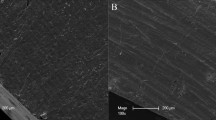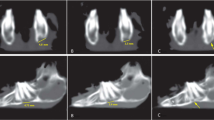Abstract
Purpose
This prospective study was conducted to evaluate the bone regeneration capacity of synthetic hydroxyapatite mixed with autogenous bone marrow aspirate when used as a bone graft substitute in maxillo-mandibular osseous defects.
Methods
This study included nine patients with histopathalogically proven benign osteolytic lesions in maxilla and mandible that were treated with enucleation or marginal resection followed by bone marrow aspirate coated synthetic biphasic hydroxyapatite (hydroxyapatite and beta tricalcium phosphate) graft placement. Incorporation of graft was assessed based on Irwin’s radiologic staging. The efficacy of graft to form new bone was radiologically evaluated by observing the sequential changes of density at grafted site using gray scale level histogram which was processed in adobe photoshop 7.0 elements. Clinical assessment of recipient and donor sites was done.
Results
Based on Irwin’s radiologic staging, at 6 month follow up period, obvious incorporation of graft with new bone was observed. Sequential changes in bone density measured by gray scale histogram revealed initial resorption followed by replacement of BMA coated hydroxyapatite with new bone formation. None of the patients eventually had complications like infection, wound dehiscence, graft loss at recipient sites at 6 months follow up period.
Conclusion
Autogenous bone marrow aspirate in combination with synthetic hydroxyapatite is an effective option for accelerating bone regeneration in small to moderate sized jaw bone defects. This mixture provides all the three critical elements needed for bone regeneration (osteogenesis, osteoinduction and osteoconduction) with an added advantage of obviating donor site morbidity.







Similar content being viewed by others
References
Chiapasco M, Rossi A, Motta JJ, Crescentini M (2000) Spontaneous bone regeneration after enucleation of large mandibular cysts: a radiographic computed analysis of 27 consecutive cases. J Oral Maxillofac Surg 58:942–948
Friedlaender GE, Strong DM, Tomford WW, Mankin HJ (1999) Long-term follow-up of patients with osteochondral allografts: a correlation between immunologic responses and clinical outcome. Orthop Clin N Am 30:583–588
Morisue H, Matsumoto M, Chiba K et al (2006) Novel hydroxyapatite fiber mesh as a carrier for recombinant human bone morphogenetic protein-2 enhances bone union in rat posterolateral fusion model. Spine 31:1194–1200
Brandoff JF, Siber JS, Vaccaro AR (2008) Contemporary alternatives to synthetic bone grafts for spine surgery. Am J Orthop 37:410–414
Muschler GF, Boehm C, Easley K (1997) Aspiration to obtain osteoblast progenitor cells from human bone marrow: the influence of aspiration volume. J Bone Joint Surg Am 79:1699
Ross MH, Romrell LJ, Kaye GI (1995) Histology: a text and atlas. Williams and Wilkins, Baltimore, pp 150–154
Pasqualini D, Mollo L, Scotti N, Cantatore G, Castellucci A, Migliaretti G, Berutti E (2012) Postoperative pain after manual and mechanical glide path: a randomized clinical trial. J Endod 38:1
Irwin RB (2001) Coralline hydroxyapatite as a bone graft substitute in orthopedic oncology. Am J Orthop 30:544–550
Pradel W, Eckelt U, Lauer G (2006) Bone regeneration after enucleation of mandibular cysts: comparing autogenous grafts from tissue-engineered bone and iliac bone. Oral Surg Oral Med Oral Pathol Oral Radiol Endod 101:285–290
Boden SD, Schimandle JH (1995) Biologic enhancement of spinal fusion. Spine 20:113S–123S
Spivak JM, Hasharoni A (2001) Use of hydroxyapatite in spine surgery. Eur Spine J 10:S197–S204
Hulbert SF, Cooke FW, Klawitter JJ, Leonard RB, Sauer BW et al (1973) Attachment of prosthesis to musculoskeletal system by tissue ingrowth and mechanical inter locking. J Biomed Mater Res 7:1–23
Karageorgiou V, Kaplan D (2005) Porosity of 3D biomaterial scaffolds and osteogenesis. Biomaterials 26(27):5474–5491
Hirano S, Shoji K, Kojima H, Omori K (1997) Use of hydroxyapatite for reconstruction after surgical removal of intraosseous hemangioma in the zygomatic bone. Plast Reconst Surg 100:86–90
Bierman HR (1952) Bone marrow aspiration of the posterior iliac crest, an additional safe site. Calif Med 77(2):138–139
Benzel Edward C (2012) Spine surgery: techniques, complications, avoidance and management, 3rd edn. Saunders, Philadelphia, pp 1–18
Bansal S, Chauhan V, Sharma S, Maheshwari R, Juyal A, Raghuvanshi S (2009) Evaluation of hydroxyapatite and beta-tricalcium phosphate mixed with bone marrow aspirate as a bone graft substitute for posterolateral spinal fusion. Ind J Orthop 43:3
Nagahara K et al (1992) Osteogenesis of hydroxyapatite and tricalcium phosphate used as a bone substitute. Int J Oral Maxillofac Implants 7:72–79
Zijderveld SA, Zerbo IR, van den Bergh JP et al (2005) Maxillary sinus floor augmentation using beta-tricalcium phosphate (Cerasorb) alone compared to autogenous bone grafts. Int J Oral Maxillofac Implants 20(3):432–440
Author information
Authors and Affiliations
Corresponding author
Ethics declarations
Conflict of interest
None.
Rights and permissions
About this article
Cite this article
Gali, R.S., Devireddy, S.K., Mohan Rao, N. et al. Autogenous Bone Marrow Aspirate Coated Synthetic Hydroxyapatite for Reconstruction of Maxillo-Mandibular Osseous Defects: A Prospective Study. J. Maxillofac. Oral Surg. 16, 71–78 (2017). https://doi.org/10.1007/s12663-016-0924-4
Received:
Accepted:
Published:
Issue Date:
DOI: https://doi.org/10.1007/s12663-016-0924-4




